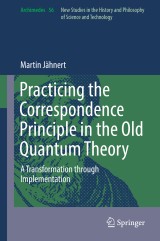Details

Practicing the Correspondence Principle in the Old Quantum Theory
A Transformation through ImplementationArchimedes, Band 56
|
CHF 142.00 |
|
| Verlag: | Springer |
| Format: | |
| Veröffentl.: | 20.06.2019 |
| ISBN/EAN: | 9783030133009 |
| Sprache: | englisch |
Dieses eBook enthält ein Wasserzeichen.
Beschreibungen
<p>This book presents a history of the correspondence principle from a new perspective. The author provides a unique exploration of the relation between the practice of theory and conceptual development in physics. In the process, he argues for a new understanding of the history of the old quantum theory and the emergence of quantum mechanics.</p><p>The analysis looks at how the correspondence principle was disseminated and how the principle was applied as a research tool during the 1920s. It provides new insights into the interaction between theoretical tools and scientific problems and shows that the use of this theoretical tool changed the tool itself in a process of transformation through implementation. This process, the author claims, was responsible for the conceptual development of the correspondence principle.</p><p> </p><p>This monograph connects to the vast literature in the history of science, which analyzed theoretical practices as based on tacit knowledge, skills, and calculation techniques. It contributes to the historical understanding of quantum physics and the emergence of quantum mechanics. Studying how physicists used a set of tools to solve problems, the author spells out the ‟skillful guessing” that went into the making of quantum theoretical arguments and argues that the integration and implementation of technical resources was a central driving force for the conceptual and theoretical transformation in the old quantum theory.</p><p></p>
1. Introduction.- 2. The Correspondence Principle in Copenhagen 1913–1923: Origin, Formulation and Consolidation.- 3. The Correspondence Principle in the Quantum Network 1918–1926.- 4. Using the Magic Wand: Sommerfeld, Multiplet Intensities and the Correspondence Principle.- 5. Fertilizer on a Sandy Acreage: Franck, Hund and the Ramsauer Effect.- 6. That I Cannot Conceive of After the Results of Your Dissertation: Fritz Reiche and the F-sum Rule.- 7. Copenhagen Reactions: The Intensity Problem in Copenhagen, 1924–1925.- 8. Conclusion.- A. Applications of the Correspondence Principle 1918–1928.- Archives.- Bibliography.<div><br></div>
Martin Jähnert is a historian of science focused on conceptual developments in 19th- and 20th-century physics. As a fellow at the Berlin Center for the History of Knowledge he is currently working on the history of photometry as practiced at lighthouses in the 19th century. He was part of the project History and Foundation of Quantum Physics at the Max Planck Institute for the History of Science where he worked on the conceptual development of the old quantum theory, in particular of the correspondence principle and the interpretational debate on quantum mechanics in the 1920s.<br> <br><div>Jähnert studied History and Physics at Humboldt-Universität zu Berlin and completed his Ph.D. thesis Practicing the Correspondence Principle in the Old Quantum Theory at the Max Planck Institute for the History of Science and the Technische Universität Berlin. Currently he is a post-doc at the Berlin Center for the History Knowledge with the project “Photometry at the Lighthouse”.</div>
<p>This book presents a history of the correspondence principle from a new perspective. The author provides a unique exploration of the relation between the practice of theory and conceptual development in physics. In the process, he argues for a new understanding of the history of the old quantum theory and the emergence of quantum mechanics.</p>
<p>The analysis looks at how the correspondence principle was disseminated and how the principle was applied as a research tool during the 1920s. It provides new insights into the interaction between theoretical tools and scientific problems and shows that the use of this theoretical tool changed the tool itself in a process of transformation through implementation. This process, the author claims, was responsible for the conceptual development of the correspondence principle.</p>
<p>This monograph connects to the vast literature in the history of science, which analyzed theoretical practices as based on tacit knowledge, skills, and calculation techniques. It contributes to the historical understanding of quantum physics and the emergence of quantum mechanics. Studying how physicists used a set of tools to solve problems, the author spells out the ‟skillful guessing” that went into the making of quantum theoretical arguments and argues that the integration and implementation of technical resources was a central driving force for the conceptual and theoretical transformation in the old quantum theory.</p><p></p><p></p>
<p>The analysis looks at how the correspondence principle was disseminated and how the principle was applied as a research tool during the 1920s. It provides new insights into the interaction between theoretical tools and scientific problems and shows that the use of this theoretical tool changed the tool itself in a process of transformation through implementation. This process, the author claims, was responsible for the conceptual development of the correspondence principle.</p>
<p>This monograph connects to the vast literature in the history of science, which analyzed theoretical practices as based on tacit knowledge, skills, and calculation techniques. It contributes to the historical understanding of quantum physics and the emergence of quantum mechanics. Studying how physicists used a set of tools to solve problems, the author spells out the ‟skillful guessing” that went into the making of quantum theoretical arguments and argues that the integration and implementation of technical resources was a central driving force for the conceptual and theoretical transformation in the old quantum theory.</p><p></p><p></p>
Presents a history of the correspondence principle from a new perspective Argues for a new understanding of the history of the old quantum theory and the emergence of quantum mechanics Offers new insights into the relation between the practice of theory and conceptual development in physics

















